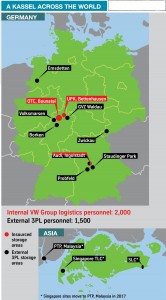
As reflected in its main location, Depot Kassel plays a central role in the Volkswagen Group’s global service parts strategy, requiring flexibility as well as a high level of automation.
Kassel/Baunatal serves the Volkswagen Group value chain from many angles. The component plant there opened in 1957 and has expanded to become the group’s most important transmission and exhaust system centre, building more than 4m units of each per year; it has Europe’s largest light foundry, producing aluminium and magnesium gearbox housing and other body parts, as well as electric motors.
For 40 years Kassel has also been the main centre for rebuilding millions of parts, engines and gearboxes for the aftermarket. The plant is part of the basis for having the OTC here, as it is the depot’s largest single supplier. All of its inbound logistics are also shared with the plant and the wider production network using Gebietspediteure, a typically German area forwarding approach that consolidates parts from each region with single logistics providers.
Kassel is a logistical centrepoint of Germany and Europe for Volkswagen. Draw a line starting from the port of Bremerhaven going south-west to Munich, Austria and Italy; or from Hamburg south-east through Hanover to Frankfurt and down to the borders with France and Switzerland; or from Berlin west through the Ruhr region to Brussels. All these axes intersect at a point near Kassel, connecting it along dense logistics routes to major markets, ports and airports, as well as the wider regional supply base.
For such a central location, Kassel also has good rental prices for warehousing. The region is more competitive than around Frankfurt or in the north, with rates much lower than many overseas locations as well.
Kassel first served as a central parts operation for Volkswagen as far back as 1969, when it installed the parts reconditioning hall at the plant. Over time, more central aftermarket operations were moved here, including the consolidation of Volkswagen and Audi genuine parts in 1975.
“It was a big change for the Volkswagen Group when we launched the OTC in 1994 as a central platform and a group function,” says the head of Depot Kassel, Dr Claus Wriebe.
Kassel is now a major operational, management and strategic centre for the group’s services parts. Offices at OTC 1 are the headquarters for the Group Genuine Parts and Service division.
The OTC is also the headquarters of Volkswagen Genuine Parts Logistics (Original Teile Logistik GmbH, or OTLG), a wholesaler that controls the group’s seven regional depots in Germany, and in which the Volkswagen Group owns a majority of the shares. The distribution centre VZ Mitte is one of the OTLG’s depots and is located onsite within the OTC 2, receiving material directly from picking areas, and delivering to dealers around Kassel and north to Wolfsburg.
Claus Wriebe and his team also manage operations across ‘Depot Kassel’ – internally referred to as K-VO-D – from their offices here, with departments that cover logistics procurement, logistics controlling and support, warehouse and transport logistics, as well as costs and supply concepts such as crossdocking and non-stocking assortment. For example, Depot Kassel currently has a significant focus on reducing inbound logistics costs, among other topics.
Nearly 2,000 group employees, mostly hourly staff, work across the internal facilities of Depot Kassel, making it the largest labour group within the Genuine Parts division. There are a further 1,500 external employees in Depot Kassel’s 3PL-run warehouses.
 Click to enlarge
Click to enlargeUnderstanding processes and automation at Depot KasselThe ten sites of Depot Kassel have varying functions and degrees of autonomy in relation to the OTC. The main process split is that core picking and dispatch operations are kept in-house by Volkswagen Group employees, especially at the OTC, while 3PLs run external warehouses that do replenishment and packing that feed the OTC.
The centralisation of processes allows for considerable automation in parts picking, most of which is concentrated in OTC 1. Of the more than 13m picks expected at the OTC for 2015, around 9m happen in OTC 1, with 3.8m alone at the automated-small box operation, known as the KLT warehouse.
The KLT facility stores 271,000 boxes, with picks guided by workstations where employees choose parts and fill boxes with a push of a button. The new layouts here have been based on method-time measurements (MTM), are height-adjustable and have screens showing what parts to pick. Faster, operator-less cranes now pick and refill boxes off shelves up to 15 metres high. Each worker at the KLT operation has capacity for around 100 picks per hour.
Volkswagen also expanded picking capacity with its new ‘high-rack storage area 2’ in OTC 1. At full capacity this site, which stores 45,000 boxes, will add 800,000 picks per year. The floors of the workstations are also adjustable for workers to improve ergonomics, with cranes to lift heavier boxes. The conveyor system was extended to connect to storage centres and dedicated truck, rail and ocean shipping areas.
However, the OTC is more than a picking centre. A large amount of replenishment is done centrally here, including at the large, automated ‘high-rack storage area 1’, also in OTC 1. At this captivating operation, driverless cranes move parts in and out of storage across racks as high as 38 metres, controlled by a central IT system. This area stores parts of various different sizes, and typically holds 12 days of stock.
 The OTC in Kassel has high levels of automation for both picking and replenishment operations
The OTC in Kassel has high levels of automation for both picking and replenishment operationsOTC 1 has the highest automation rate of the five Kassel facilities in terms of automated replenishment and ‘goods to person’ picking processes (Ware zum Mensch). Here, automation applies for around 20% of the assortment, which make up the fast-moving parts.
Other areas also use manual processes (such as traditional ‘person-to-goods’ picking, or Mensch zur Ware in German), forklifts or order-picker trucks, including areas for small and larger pallets and a narrow-aisle warehouse, as well as at OTC 4, which receives returned parts and empty containers.
Some manual processes are set for more automation, notably at the container shipping area in OTC 1, which stuffs containers for onward shipment to Hamburg and Bremerhaven. Currently, goods stored in the OTC destined for overseas are repackaged manually from the metal boxes in which they are stored into one-way packaging. “With this investment we will reach benchmark level for overseas outbound dispatch,” says Wriebe. “By doing so we will be able to reduce our overall lead times for overseas by five days. We also will have a positive effect due to a significant inventory reduction.”
Other warehouses in the network are generally for packing and replenishment, including local, 3PL-run sites in nearby Borken, Volkmarsen and Waldau, as well as further away in Emsdetten, in North-Rhine Westphalia. At Zwickau, in eastern Germany, the group stores slow-moving, strategic part numbers, such as for models ten years old or more. “These parts have to be held a long time, but we can do it here because the space is very inexpensive,” says Wriebe.
However, some offsite locations do picking as well. The UPK, at a business park about 15km from the OTC, is an in-house warehouse for replenishment and picking. In Ingolstadt, Audi operations are similar to the OTC, with both an outsourced packaging operation and in-house warehouses for picking, including an automated KLT facility.
Singapore, which is outsourced to a 3PL, is another picking and dispatching location, holding both European content received from the OTC and direct shipments from Asian suppliers, and distributing to wholesalers in Asia Pacific.
Dispatches can also be sent directly from external warehouses if the volume is large enough for an order, as well as from suppliers in some cases. Depot Kassel is improving its systems to do more direct deliveries. “Otherwise, it is nonsense to move those parts first to Kassel, and then onward to wholesalers,” says Wriebe. “We specifically designed the warehouses to be large enough to fill trucks or a train for dispatch, but it is a careful planning process.”
Even by Claus Wriebe’s own admission, packing for warehouse stocking is a tough business for 3PLs. In particular, they must deal with considerable variations in inbound volumes. “For that reason we are working with 3PLs that, in addition to having a high quality standard, are highly flexible in their personnel, staff planning, steering and control,” he says.
That is why Depot Kassel plans to centralise more packaging into what Wriebe calls “an ideal packaging” warehouse, which will include higher levels of automation and more ergonomic workstations. The warehouse, which is still in the planning phase, will feed picking and replenishment centres at the OTC.
“This will be a huge project and requires a lot of study and benchmarking to consider new automation processes and warehouse design,” says Wriebe. “For example, a packaging warehouse doesn’t need high rack shelving, but it will need more gates for different deliveries.”
Although automated, the packaging warehouse will still require around 700 workers, for which 3PLs will be responsible.
However, Wriebe wants to use multiple providers rather than concentrating everything in one company’s hands. Some operations at the OTC and external warehouses around Kassel would also be affected, but the full network impact will depend on volume, he says.
That is partly why Volkswagen will switch two Singapore locations to one in a free-trade zone in the Malaysian port of Tanjun Pelenas (PTP), less than 50km from one of its current Singapore locations. The move will have positive effects on reducing warehouse and logistic costs for the group in the region, while throughput times will also be reduced. As PTP is close to Singapore and a major container port itself, there will be no significant logistics disadvantages, says Claus Wriebe.
“Due to the fact that the industrialisation level in Malaysia is not as high as it is in Singapore, we have to pay close attention to making sure we have a well-qualified and trained staff during the implementation,” says Wriebe.
To ensure a smoother transition, Volkswagen will keep its current 3PL during the changeover. “Taking into account the service and the security of supply, we want to stabilise the process and minimise the risks,” he says. “So we think it will be better to do changes step by step.”
Balancing 3PLs and labourVolkswagen uses 3PLs at its warehouses for several reasons, including to allow its own staff to focus more on core competences, including picking and outbound dispatch. It is also a way to stay flexible in managing inconsistent inbound supply, especially for packaging and replenishment.
“Our suppliers don’t deliver to us in a consistent flow, which is one of our biggest challenges,” he says. “Sometimes we receive 70 inbound trucks a day, other times 120.”
Across external warehousing, replenishment takes up the most space, though packaging requires the most labour. Out of Depot Kassel’s more than 1.2m sq.m of total warehouse space at all its sites, 3PLs managed 600,000 sq.m, of which packaging represents 65,000 sq.m of operations, with the remaining 535,000 sq.m for replenishment. Of 1,500 3PL-staff, however, 1,000 are packing parts.
With ‘non-core areas’, such as packing, mainly in the hands of 3PLs, Volkswagen has sought to increase in-house staff working in strategic areas, like picking and dispatch. One example of a business area that Volkswagen recently in-sourced at Depot Kassel is the distribution of workshop equipment for repair and installation work at dealers, including tooling and small robots.
“The foundation is the so-called Volkswagen Weg [Volkswagen Way], which is adopted together with the workers’ council. With its elements like teamwork, target agreement and continuous improvement processes, we are working together with our staff on a permanent process enhancement,” says Wriebe.




































